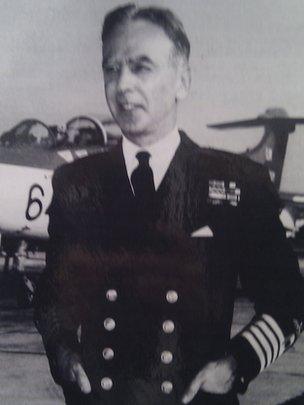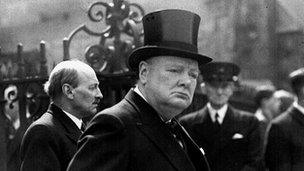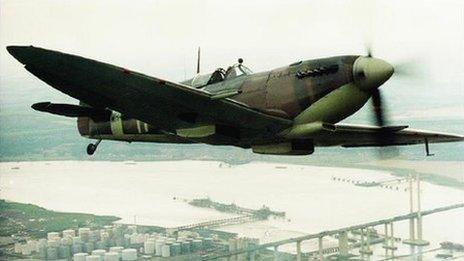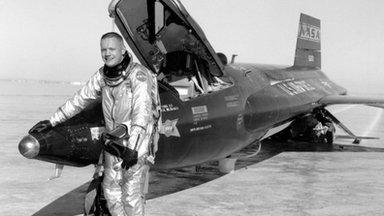Captain 'Winkle' Brown: Is he the greatest pilot ever?
- Published

Captain Eric 'Winkle' Brown has flown 487 different types of aircraft
Captain Eric 'Winkle' Brown has flown more types of aircraft than anyone in history, survived 11 crashes, interrogated high-ranking Nazis, and met everyone from wartime leader Winston Churchill to first man on the moon, Neil Armstrong.
He is a war hero in the truest sense of the word. Now aged 94, the Edinburgh-born fighter pilot says he has finally "buckled down to domestic life".
Eric 'Winkle' Brown is no ordinary aviator.
He is part of an elite group of test pilots who took the untried - and sometimes deadly - theories of aeroplane designers down the runway and into the sky.
Over his career, he flew 487 different types of aircraft, a world record that is unlikely ever to be matched.
It's a job that requires a certain type of personality, he told Radio Four's PM programme.

After the liberation of Belsen concentration camp, Captain Brown interrogated notorious female commander Irma Grese
"I have a nature that doesn't panic in these situations," he said.
"My brain goes very sort of cold, and very good at considering things."
Nobody is without fear, he said, but there was often a casual attitude among the other pilots.
"They'd say "kick your tyres, light your fires, and the last one off's a sissy".
"I was not of that school at all. I always put two things down to my survival. I was always meticulous in my preparation.
"Secondly, my height - I'm only 5ft 7in - saved me because there were occasions I would have lost my legs in crashes."
It was his height that earned him his nickname "Winkle" - short for "periwinkle", a type of small mollusc - from his colleagues.
"I would put my legs under the seat and curl up like a little ball in the cockpit," he said.
Captain Brown, the most decorated test pilot of all time, was also the first person ever to land a jet on an aircraft carrier in 1945.
He described the moment like being a "matchbox floating in a bath".
Unlikely encounters
Captain Brown was bitten by the flying bug at the tender age of eight, after his father, a pilot in the Royal Flying Corps during WWI, first took him up in a plane.
"It was a single seat bi-plane," he said.
"There was no second seat, but I sat on his lap and he let me handle the stick.
"It was exhilarating. You saw the earth from a completely different standpoint."
It was a career that would take Captain Brown to the most unlikely of places and encounters.
He met Churchill, and King George VI on a number of occasions.
He was at the liberation of Bergen Belsen concentration camp.
"What we saw was just unbelievable," he said.
"There were piles of bodies as high as this roof, and a lot of people walking around like zombies, no idea what was going on at all. There were just half dead.
"They had taken a bulldozer and bulldozed the bodies into a pit. They were lying in terribly grotesque positions, arms and legs all over the place.
"That's not what really got to me. It was this appalling stench. It still does stick in my gullet."
Unbelievable cruelty
Brigadier Glynn Hughes, who had taken control of Belsen, called on Captain Brown to interrogate the camp's two head guards because of his fluent German.
"Josef Kramer was the head guard, and responsible for the deaths of thousands of people," he said.
"He didn't deny anything. He realised the game was up."

Captain Brown met Churchill, and King George VI on a number of occasions.
But it was the camp's 22-year-old female commander, Irma Grese, nicknamed the "beautiful beast of Belsen", that Winkle Brown described as "the worst human being I have ever met".
"Her cruelty in Auschwitz was unbelievable," he said.
"She was the one who made lampshades from the skins of prisoners and that sort of thing.
"The brigadier said 'ask her if she had her time over again would she do this again?'. She didn't answer.
"I was keeping at it when she suddenly leapt to her feet and said 'Heil Hitler', and sat down again.
"We never got anything out of her at all. She didn't seem to have any feeling at all about human beings."
Forged papers
She was not the only high-profile Nazi that Winkle Brown interrogated.
He also interviewed top-ranking Nazis Hermann Goering and Heinrich Himmler, who set up and controlled the Nazi concentration camps.

Captain Brown flew 14 version of the Spitfire and many other iconic planes during his career
Himmler was originally captured under a false identity.
"This chap called himself Heinrich Hitzinger. And his papers were forged. But the warrant officer kept at him and kept at him.
"Eventually he got mad with this thing, and he said 'I'm Heinrich Himmler'.
"And the warrant officer said 'yes and I'm Julius Caesar'.
"He didn't believe him at all."
Captain Brown described Himmler as a "snivelling coward".
"He was so frightened of what would happen to him. It was all aimed at saving his own skin," he said.
'King of the castle'
Captain Brown's long career brought him into contact with another former pilot, astronaut Neil Armstrong, the first person to walk on the moon.
They later became close friends.

Captain Brown became close friends with astronaut Neil Armstrong, who was the first man to walk on the moon
"In fact when I met Neil, to my horror and embarrassment, I really didn't recognise him," he said.
"He said 'well, I'm a naval aviator like you are and I've heard of your deck landing exploits'.
"There we are, I'm talking to the guy who is the top dog of the lot, and he knows me and I don't recognise him. How embarrassing."
"Here was a man who touched the hand of God. And yet modest beyond words, so modest in fact that he didn't want anyone to talk about it."
But Captain Brown said he would still sooner be a test pilot than an astronaut.
"It is a huge thrill," he said.
"You're up there on your own, and you really feel like this is life. I'm the king of the castle up here. That's really what it's like."